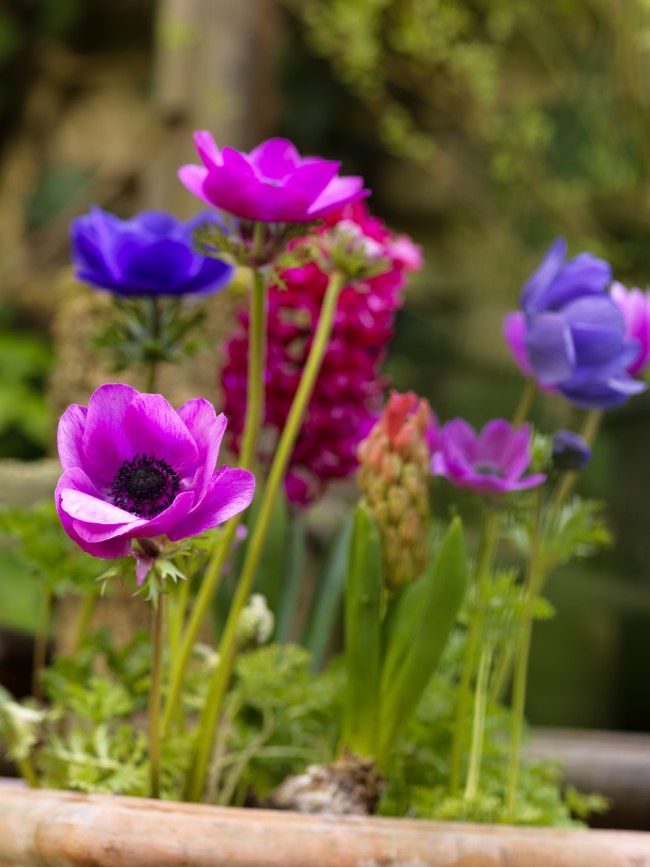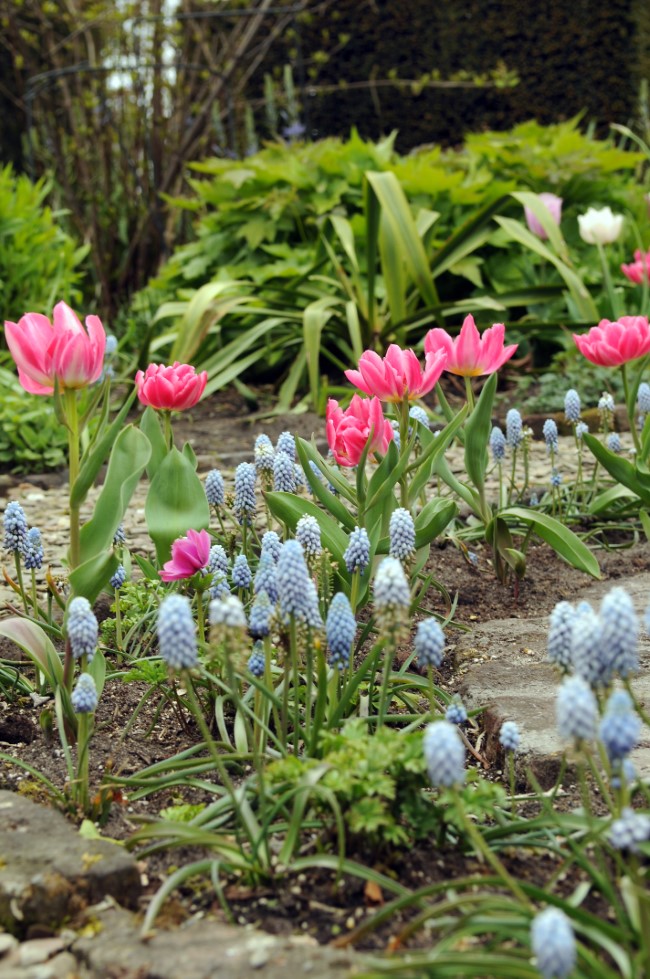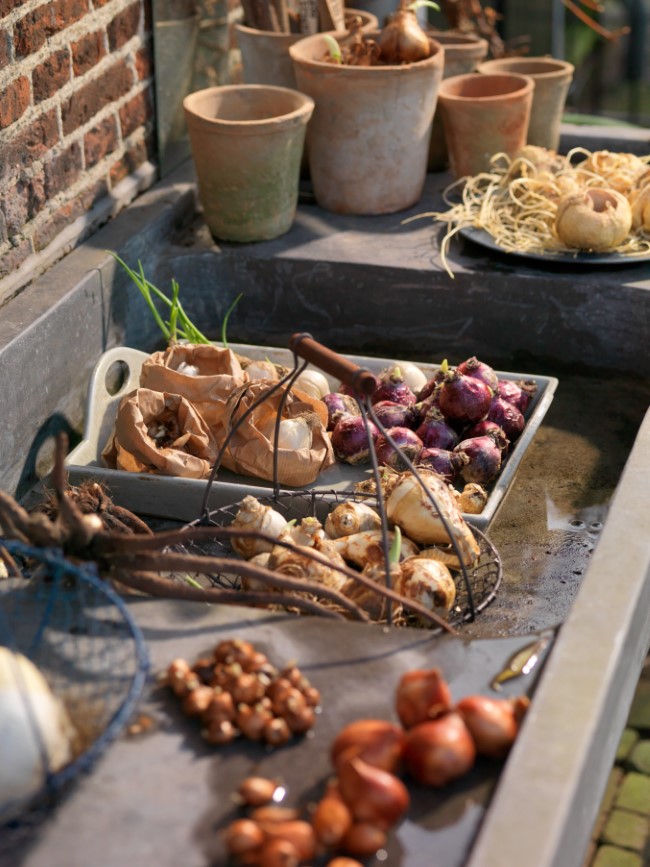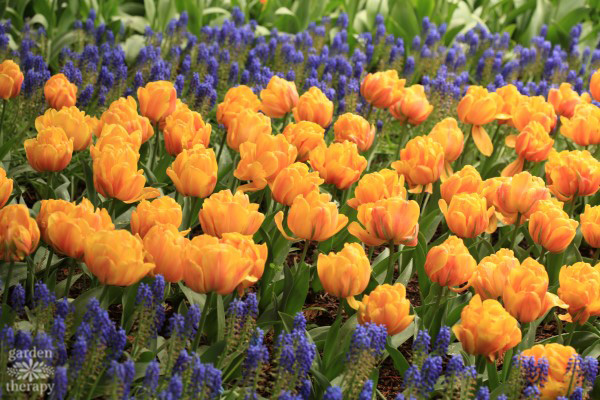The spring garden is a joyous sight full of colour and happy blooms, many of which come from bulbs (or corms and tubers) that are planted in the fall. Spring gardening may be the last thing on your mind while you are busily tending to autumn chores, but take a bit of time to plant some fall bulbs and I know you will be thanking me next year for this little reminder!

Fall bulbs are also known as spring flowering bulbs. The two terms are used interchangeably and both are technically correct as the bulbs are available for sale and planted in the fall, but they flower in the spring. There are also a number of lovely bulbs you plant in the spring for summer blooms. These would be most accurately called summer flowering bulbs as it could be too confusing to call them spring bulbs.
No matter what you call them, they make wonderful garden decoration and cut flowers to bring inside the house. They are easy to plant and if they are happy in the spot you’ve put them in, they will come back year after year (in most cases).

Really, what’s not to love?
The only caveat is that you need to REMEMBER to plant them in the fall because they required a period of cold temperatures to stimulate root development. I think that’s why I’ve always heard them called “fall bulbs;” from the messaging that is out there reminding us gardeners to get planting the bulbs that will grow our spring flowers.
 What’s in a Name? Bulbs, Corms, and Tubers
What’s in a Name? Bulbs, Corms, and Tubers
Flower “bulb” is the commonly used term for a swollen underground plant part such as a true bulb, corm, or tuber. While it’s not unusual to group these types of plants together because they share similar planting and storage characteristics, it can be helpful to know the difference when cultivating the different types of plants.
FlowerBulbs.com helps to clarify more for us, “Technically speaking, many popular “bulb” flowers are not produced from true flower bulbs at all. Crocuses and gladioli, for example, are really corms, while such favorites as dahlias and begonias are really tubers. The main distinguishing trait is their method of storing food. In corms, most of the food is stored in an enlarged basal plate rather than the fleshy scales which in corms are much smaller.”

Planting and Caring for Fall Bulbs
This guide will cover when to plant spring-flowering fall bulbs, how to plant them, watering needs, overwintering, and designing your bulb garden.
When to Plant Spring Flowering Fall Bulbs
Spring-flowering bulbs get planted sometime in the fall but the timing varies for each type of flowers. As a general rule, plant them as early in the fall as you can so that the bulbs have a chance to develop a strong root system. At the very latest they must go in the ground before the last frost.
If you’re buying your bulbs from a mail-order company they won’t ship them out until the ideal planting time for your area, so the work is usually done for you. If you are purchasing bulbs from a garden centre, they will often stock them a bit earlier than the ideal planting date and continue selling them until they are sold out, possibly long after frost. Be sure to thoroughly read the instructions and timing for planting the individual bulbs to get the best results.
It’s best to plant bulbs as soon as they arrive in the mail or you pick them up at the garden center. If you have to delay planting for some reason then store them in a dry cool location, out of direct sunlight, where temperatures are between 50 – 60 degrees Fahrenheit.

How to Plant Bulbs
Your bulbs should come with full instructions for how to plant them, but for some general guidelines, here are some professional planting tips from FlowerBulbs.com.
SPONSORED CONTENT: This following excerpt is re-printed with permission and some of the photos in this post are courtesy of FlowerBulbs.com, a fantastic source of information on flower bulbs. Read a ton more about flower bulbs here.
“Most spring-flowering Dutch flower bulbs will thrive in either full or partial sun but will do just fine in almost any location that offers good drainage. Flower bulbs will rot in standing water, so avoid areas prone to flooding such as at the bottom of slopes or under drainage pipes.
After choosing the site:
- Dig either a trench for a bed planting or individual holes for individual flower bulbs or small cluster of flower bulbs. To determine how deep to plant, consider the diameter or size of the flower bulb. Large flower bulbs (2 inches across or more) are usually planted about 6 inches deep; smaller-sized flower bulbs (1 inch) are planted 3-4 inches deep.
- Loosen the soil with a rake to aerate it and also remove any weeds and small stones. Mix in a bit of peat moss to improve soil drainage. Place – do not push – bulbs firmly in the soil with the pointed side up. Space large bulbs 3-8 inches apart and small bulbs 1-3 inches apart. (If you’re not sure which end is right side up, don’t worry. Upside-down flower bulbs usually come up anyway!)
- Cover the flower bulbs with soil and then water generously if the soil is not yet moist. Add 2-3 inches of mulch (pine bark is fine) on top of the garden bed. This will provide added protection from the cold and keep the soil from drying out.”
Designing With Spring Flowering Bulbs
Now, let’s look at how to design with bulbs in the garden.
Note: spring-flowering bulbs also are wonderful when planted in pots. Get some inspiration and read more on How to Plant and Overwinter Spring-Flowering Bulbs in Pots.
Just as there are many garden styles there are many different ways of planting bulbs in your garden. They can be scattered throughout the beds popping up between perennials and shrubs. They can create a decorative border lining a walkway or framing evergreen garden features. Or they can be layered so that you have intentional waves of blooms producing consistently over many months.

Scattering Bulbs Throughout the Garden
Spring-flowering bulbs are the perfect way to add some lively colour to a garden filled with perennials, shrubs, and trees that are dormant in the winter. While the perennials and shrubs are beginning to set out new shoots and leaves, strategically-placed bulbs fill in the spaces.

Choose bulbs that bloom at the times when your perennials trees and shrubs are dormant. Then plant them in groups of five to seven around the roots of the dormant plants.
To allow the bulbs to naturalize with the existing plants, be sure to plant in the loose soil near the plants and mark the spot so you don’t accidentally dig the bulbs up when dividing the perennials.

Planting Bulbs in a Border
A border of fall bulbs is a lovely way to line a walkway or the front of a garden bed. The placement of these bulbs is the opposite of planting them above the roots of perennials and shrubs. Instead, you will plant these deeper in the soil and add annuals above them to fill in those months that they are not blooming.
These bulbs are planted in the fall, at which time you can plant fall annuals in the soil above. In the spring the bulbs will bloom, and when they die back the soil above can be planted again with summer annuals.
Layering Bulbs
Layering fall bulbs refers to planting different types of flower bulbs at different depths in the soil to stagger the bloom times and increase the number of flowers that you can get in a small space. Many refer to this as planting flower bulb lasagna.

To layer fall bulbs, select a combination of bulbs that will do well in similar conditions, but that have different bloom times, heights, and decorative features like colour. Plant the bulbs at the recommended planting depth, which will usually be planting larger bulbs into the ground around 6 to 8 inches deep, medium bulbs above them at 3 to 5 inches deep, and the smallest in the top 1 to 2 in of soil. Get detailed instructions, photos, and a DIY soil recipe in this post on Preparing Fall Bulb Planters for Spring.
Overwintering Fall Bulbs
Spring-flowering fall bulbs will not only tolerate cool winter soil, but they need it in order to thrive. Many bulbs are tolerant of many different soil types as well, as much as what they need to grow is stored in the bulb. The biggest question that many people have around overwintering bulbs is if to water them or not.
The answer is, “not really.”

Newly planted bulbs should be watered in the fall in an area that drains well. As a season cools, they do not need to be watered, but also don’t need to be protected from rain or snow as long if the bulbs you are choosing are suitable to plant in your climate and hardiness zone. As long as the soil is free-draining and they aren’t left sitting in standing water, they will be happily dormant until the spring. In spring watering is only necessary if the soil is dry.
Hopefully you now have everything you need to get out there and plant some fall bulbs! If you still have questions like, “do they need to be lifted out of the garden after blooming?” or “will deadheading increase blooms?” Flowerbulbs.com has some great answers to common questions about bulbs in their FAQ section.
Giveaway Time!
This contest is now closed. Congratulations to Cathy!
But Wait! There are More Bulbs to Love!
- Preparing Fall Bulb Planters for Spring
- Protect Your Garden from Vampires: How to Grow Garlic
- Beyond Tulips: 12 Extraordinary Spring Flowering Bulbs to Plant in Fall
- Fall Container Care and Maintenance + DIY Container Ideas
- Bring on Spring! How to Force Spring Bulbs Indoors
- Plant Summer-Blooming Bulbs in the Spring for an Outstanding Display This Year

 What’s in a Name? Bulbs, Corms, and Tubers
What’s in a Name? Bulbs, Corms, and Tubers



I love tulips!